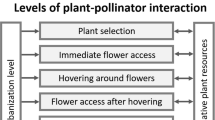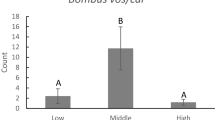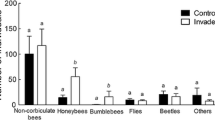Abstract
The majority of plant species rely, at least partly, on animals for pollination. Our knowledge on whether pollinator visitation differs between native and alien plant species, and between invasive and non-invasive alien species is still limited. Additionally, because numerous invasive plant species are escapees from horticulture, the transition from human-assisted occurrence in urbanized habitats to unassisted persistence and spread in (semi-)natural habitats requires study. To address whether pollinator visitation differs between native, invasive alien and non-invasive alien species, we did pollinator observations for a total of 17 plant species representing five plant families. To test whether pollinator visitation to the three groups of species during the initial stage of invasion depends on habitat type, we did the study in three urbanized habitats and three semi-natural grasslands, using single potted plants. Native plants had more but smaller flower units than alien plants, and invasive alien plants had more but smaller flowers than non-invasive alien plants. After accounting for these differences in floral display, pollinator visitation was higher for native than for alien plant species, but did not differ between invasive and non-invasive alien plant species. Pollinator visitation was on average higher in semi-natural than in urbanized habitats, irrespective of origin or status of the plant species. This might suggest that once an alien species has managed to escape from urbanized into more natural habitats, pollinator limitation will not be a major barrier to establishment and invasion.

Similar content being viewed by others
References
Baker HG (1955) Self-compatibility and establishment after “long-distance” dispersal. Evolution 9:347–349
Baker HG (1974) The evolution of weeds. Ann Rev Ecol Syst 5:1–24
Bartomeus I, Vilà M (2009) Breeding system and pollen limitation in two supergeneralist alien plants invading Mediterranean shrublands. Aust J Bot 57:109–115
Bartomeus I, Vilà M, Santamaría L (2008) Contrasting effects of invasive plants in plant-pollinator networks. Oecologia 155:761–770
Bjerknes AL, Totland Ø, Hegland SJ, Nielsen A (2007) Do alien plant invasion really affect pollination success in native plant species? Biol Conserv 138:1–12
Blackburn T, Pyšek P, Bacher S, Carlton JT, Duncan RP, Jarošik V, Wilson JRU, Richardson DM (2011) A proposed unified framework for biological invasions. Trends Ecol Evol 26:333–339
Brown BJ, Mitchell RJ, Graham SA (2002) Competition for pollination between an invasive species (Purple loosestrife) and a native congener. Ecology 83:2328–2336
Chittka L, Schürkens S (2001) Successful invasion of a floral market. Nature 411:653
Chrobock T, Kempel A, Fischer M, van Kleunen M (2011) Introduction bias: cultivated plant species germinate faster and more profusely than native species in Switzerland. Basic Appl Ecol 12:244–250
Dawson W, Mndolwa AS, Burslem DFRP, Hulme PE (2008) Assessing the risks of plant invasions arising from collections in tropical botanical gardens. Biodivers Conserv 17:1979–1995
Dehnen-Schmutz K, Touza J, Perrings C, Williamson M (2007a) A century of the ornamental plant trade and its impact on invasion success. Divers Distrib 13:527–534
Dehnen-Schmutz K, Touza J, Perrings C, Williamson M (2007b) The horticultural trade and ornamental plant invasions in Britain. Conserv Biol 21:224–231
Dicks LV, Corbet SA, Pywell RF (2002) Compartmentalization in plant-insect flower visitor webs. J Anim Ecol 71:32–43
Forman J (2003) The introduction of American plant species into Europe: issues and consequences. In: Brundu G, Brock JH, Camarda I, Child L, Wade M (eds) Plant invasions: species ecology and ecosystem management. Backhuys Publishers, Leiden, The Netherlands, pp 17–39
Geerts S, Pauw A (2009) African sunbirds hover to pollinate an invasive hummingbird-pollinated plant. Oikos 118:573–579
Grabas GP, Laverty TM (1999) The effect of purple loosestrife (Lythrum salicaria L.; Lythraceae) on the pollination and reproductive success of sympatric co-flowering wetland plants. Ecoscience 6:230–242
Hao JH, Qiang S, Chrobock T, van Kleunen M, Liu QQ (2011) A test of Baker′s Law: breeding systems of invasive species of Asteraceae in China. Biol Invasions 13:571–580
Harmon-Threatt AN, Burns JH, Shemyakina LA, Knight TM (2009) Breeding system and pollination ecology of introduced plants compared to their native relatives. Am J Bot 96:1544–1550
Hulme PE (2011) Addressing the threat to biodiversity from botanic gardens. Trends Ecol Evol 26:168–174
Jacobi CM, Ramalho M, Silva M (2005) Pollination biology of the exotic rattleweed Crotolaria retusa L. (Fabaceae) in NE Brazil. Biotropica 37:357–363
Jacobsson A, Padron B, Traveset A (2009) Competition for pollinators between invasive and native plants: effects of spatial scale of investigation. Ecoscience 16:138–141
Kandori I, Hirao T, Matsunaga S, Kurosaki T (2009) An invasive dandelion unilaterally reduces the reproduction of a native congener through competition for pollination. Oecologia 159:559–569
Kremen C, Williams NM, Aizen MA, Gemmill-Herren B, LeBuhn G, Minckley R, Packer L, Potts SG, Roulston T, Steffan-Dewenter I, Vázquez DP, Winfree R, Adams L, Crone EE, Greenleaf SS, Keith TH, Klein A-M, Regetz J, Ricketts TH (2007) Pollination and other ecosystem services produced by mobile organisms: a conceptual framework for the effects of land-use change. Ecol Lett 10:229–314
Lambdon PW, Pyšek P, Basnou C, Hejda M, Arianoutsou M, Essl F, Jarošik V, Pergl J, Winter M, Anastasiou P, Andriopoulos P, Bazos I, Brundu G, Celesti-Grapow L, Chassot P, Delipetrou P, Josefsson M, Kark S, Klotz S, Kokkoris Y, Kühn I, Marchante H, Perglova I, Pino J, Vilà M, Zikos A, Roy D, Hulme PE (2008) Alien flora of Europe: species diversity, temporal trends, geographical patterns and research needs. Preslia 80:101–149
Lauber K, Wagner G (2007) Flora Helvetica. Haupt Verlag, Bern, Switzerland
Marco A, Lavergne S, Dutoit T, Bertaudiere-Montes V (2010) From the backyard to the backcountry: how ecological and biological traits explain the escape of garden plants into Mediterranean old fields. Biol Invasions 12:761–779
Mitchell CE, Agrawal AA, Bever JD, Gilbert GS, Hufbauer RA, Klironomos JN, Maron JL, Morris WF, Parker IM, Power AG, Seabloom EW, Torchin ME, Vázquez DP (2006) Biotic interactions and plant invasions. Ecol Lett 9:726–740
Moragues E, Traveset A (2005) Effect of Carpobrotus spp. on the pollination success of native plant species of the Balearic Isalnds. Biol Conserv 122:611–619
Morales CL, Traveset A (2009) A meta-analysis of impacts of alien versus native plants on pollinator visitation and reproductive success of co-flowering native plants. Ecol Lett 12:716–728
Moser D, Gygax A, Bäumler B, Wyler N, Palese R (2002) Rote Liste der gefährdeten Arten der Schweiz. BUWAL, ZDSF/CRSF, CJBG, Bern, Switzerland
Muñoz AA, Cavieres LA (2008) The presence of a showy invasive plant disrupts pollinator service and reproductive output in native species only at high densities. J Ecol 96:459–467
Ne’eman G, Jürgens A, Newstrom-Lloyd L, Potts SG, Dafni A (2010) A framework for comparing pollinator performance: effectiveness and efficiency. Biol Rev 85:435–541
Ollerton J, Winfree R, Tarrant S (2011) How many flowering plants are pollinated by animals? Oikos 120:321–326
Parker IM, Haubensak KA (2002) Comparative pollinator limitation of two non-native shrubs: do mutualisms influence invasions? Oecologia 130:250–258
Payne RW, Harding SA, Murray DA, Soutar DM, Baird DB, Glaser AI, Channing IC, Welham SJ, Gilmour AR, Thompson R, Webster R (2008) The guide to GenStat Release 11, Part 2: Statistics. VSN International, Hempel Hempsted, UK
Powell KI, Krakos KN, Knight TM (2011) Comparing the reproductive success and pollination biology of an invasive plant to its rare and common native congeners: a case study in the genus Cirsium (Asteraceae). Biol Invasions 13:905–917
Pyšek P, Jarošik V, Chytry M, Danihelka J, Kühn I, Pergl J, Tichy L, Biesmeijer JC, Ellis WN, Kunin WE, Settele J (2011) Successful invaders co-opt pollinators of native flora and accumulate insect pollinators with increasing residence time. Ecol Monograph 81:277–293
R Development Core Team (2009) R: A language and environment for statistical computing. R Foundation for Statistical Computing, Vienna, Austria
Reichard SH, White P (2001) Horticulture as a pathway of invasive plant introductions in the United States. Bioscience 51:103–113
Richardson DM, Allsopp N, D’Antonio CM, Milton SJ, Rejmanek M (2000a) Plant invasions—the role of mutualisms. Biol Rev 75:65–93
Richardson DM, Pyšek P, Rejmánek M, Barbour MG, Panetta FD, West CJ (2000b) Naturalization and invasion of alien plants: concepts and definitions. Divers Distrib 6:93–107
Rodger JG, van Kleunen M, Johnson SD (2010) Does specialized pollination impede plant invasions? Int J Plant Sci 171:382–391
Schielzeth H (2010) Simple means to improve the interpretability of regression coefficients. Methods Ecol Evol 1:103–113
Thijs KW, Brys R, Verboven HAF, Hermy M (2012) The influence of an invasive plant species on the pollination success and reproductive output of three riparian plant species. Biol Invasions 14:355–365
Trant AJ, Herman TB, Good-Avila SV (2010) Effects of anthropogenic disturbance on the reproductive ecology and pollination service of Plymouth gentian (Sabatia kennedyana Fern.), a lakeshore plant species at risk. Plant Ecol 210:241–252
van Kleunen M, Dawson W, Schlaepfer D, Jeschke JM, Fischer M (2010) Are invaders different? A conceptual framework of comparative approaches for assessing determinants of invasiveness. Ecol Lett 13:947–958
Vanparys V, Meerts P, Jacquemart A-L (2008) Plant-pollinator interactions: comparison between an invasive and a native congeneric species. Acta Oecol 34:361–369
Vázquez DP, Morris WF, Jordano P (2005) Interaction frequency as a surrogate for the total effect of animal mutualists on plants. Ecol Lett 8(10):1088–1094
Weber E (2003) Invasive species of the world: a reference guide to environmental weeds. CABI Publishing, Oxford, UK
Williams NM, Cariveau D, Winfree R, Kremen C (2011) Bees in disturbe habitats use, but do not prefer, alien plants. Basic Appl Ecol 12:332–341
Winfree R, Aguilar R, Vazquez DP, LeBuhn G, Aizen MA (2009) A meta-analysis of bees’ response to anthropogenic disturbance. Ecology 90:2068–2076
Wittenberg R, Kenis M, Blick T, Hänggi A, Gassmann A, Weber E (eds) (2006) Invasive alien species in Switzerland – an inventory of alien species and their threat to biodiversity and economy in Switzerland. Federal Office for the Environment, Bern, Switzerland
Woods TM, Jonas JL, Ferguson CJ (2012) The invasive Lespedeza cuneata attracts more insect pollinators than native congeners in tallgrass prairie with variable impacts. Biol Invasions 14:1045–1059
Zuur AF, Ieno EN, Walker NJ, Savaliev AA, Smith GM (2009) Mixed Effects Models and Extensions in Ecology with R. Springer Science + Business Media, New York, USA
Acknowledgments
We thank Eva Knop for advice on pollinator observations, the land-owners for allowing us to use their meadows, three anonymous reviewers for helpful comments on a previous version, and the Plant Ecology Group of the University of Bern for valuable discussion. We gratefully acknowledge financial support by the Swiss National Science Foundation (SNF), Grant No. 31003A-117722, the German Science Foundation (DFG), Grant No. KL 1866/3-1, and the European Union FP7 collaborative project STEP (Status and Trends of European Pollinators).
Author information
Authors and Affiliations
Corresponding author
Electronic supplementary material
Below is the link to the electronic supplementary material.
Rights and permissions
About this article
Cite this article
Chrobock, T., Winiger, P., Fischer, M. et al. The cobblers stick to their lasts: pollinators prefer native over alien plant species in a multi-species experiment. Biol Invasions 15, 2577–2588 (2013). https://doi.org/10.1007/s10530-013-0474-3
Received:
Accepted:
Published:
Issue Date:
DOI: https://doi.org/10.1007/s10530-013-0474-3




